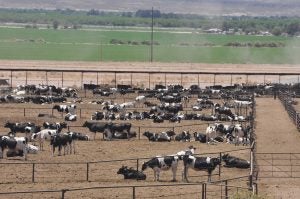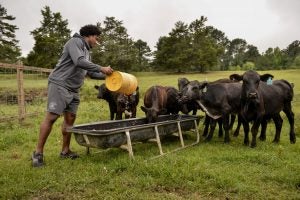When you go to the grocery store, you are faced with many choices. Food labels claim things like “hormone free,” “no antibiotics ever,” “grass-fed,” and “organic” — all of which represent different livestock production methods. By comparison, there are also grain-fed beef systems or conventionally raised chicken in the mix.
There is really no “one size fits all” way of raising livestock. In fact, there are many different livestock production techniques and methods. The question is do these different production methods actually affect nutrition?
Let’s find out if all animal protein is actually produced equally!
Grass-fed vs. grain-fed
Is the “grass-fed” label really what it seems? All cattle are grass-fed throughout at least most of their lives, but how they’re “finished” is the difference. Grass-finished cattle have access to grass their entire lives, where grain-finished cattle consume grains in addition to forages like grass and hay. Grass-fed beef and grain-fed beef have similar nutrition profiles, but grain-fed tends to be slightly higher in fat and marbling. There is really no significant difference in nutrition, which you can read more about here.
Many people can also taste a difference in flavor between grass-fed and grain-fed beef, so give both of them a try and see which you like better! At the end of the day, there isn’t a large difference in grass-fed and grain-fed beef, but you might decide that one is better for you and your family.

Organic vs. conventionally raised
Organic livestock production means that farmers need to follow strict guidelines that include things like no using antibiotics, the animals need to be raised on organic land, and the animals can’t be raised with genetic engineering. Conventional farming tends to rely more on newer technologies like veterinarian-approved antibiotics, genetic engineering, and certain pesticides on forage land, with access to all the “tools in the toolbox.”
There is little to no nutrient difference between organic and conventionally raised livestock, so the only main difference between them is personal preference and consumer price tag.

Hormone free vs. hormones in production
First things first: there is no such thing as truly hormone-free food. Pretty much all food (even plants) contains hormones, as hormones are naturally occurring in every cellular organism. When you see food labeling saying “Hormone Free” or “No Hormones,” it generally means no hormones added.
Poultry and swine are never raised with added hormones, but beef animals can be raised with growth hormones. These beef hormones include a small implant that’s placed under the skin in their ear. Beef from an implanted animal does have slightly higher estrogen levels than hormone free beef, but the difference is extremely tiny, especially when compared to other foods like eggs, tofu, or even white bread. For example, hormone-free beef contains 0.85 ng of estrogen and hormone added beef contains 1.2 ng of estrogen. Eggs contain 94 ng, white bread contains 52,029 ng, and tofu contains 19,306,201 ng of estrogen with the same serving size as beef.
When compared to other foods, the difference in hormone free and hormone added beef is miniscule — a fraction of a billionth of a gram. Beef raised with implanted hormones is also completely safe and has been tested many times. There are no other nutritional differences between.
Antibiotic free vs. conventional
“No Antibiotics Ever” means that an animal didn’t receive any antibiotics throughout its life. Conventionally, antibiotics may be used whenever an animal is sick, as just like with people, those medicines are needed in certain circumstances to treat or prevent disease. But don’t worry, all animal products that you purchase at the store will be free of antibiotics, which makes the “antibiotic free” label a bit misleading — it’s all antibiotic free! With thorough testing, following the use of withdrawal times and only using antibiotics when necessary, you will never find any harmful antibiotic residue in your food. You also won’t find any nutritional difference.
Protein from animals raised with the use of antibiotics versus animals that have had no antibiotics ever will be the same.
At the end of the day, most livestock production techniques will not affect nutrition in a substantial way. There are tiny differences in some production methods, but many are not enough to make a difference in your nutrition or health. Taking into account your personal preferences, as well as things like cost and availability, will help you decide what animal proteins are right for you.
You don’t need to worry about making a “wrong” choice in regards to nutrition. All animal proteins are delicious and will provide you with important and necessary nutrients, regardless of the livestock production method used.
Michelle Miller, the “Farm Babe,” is an internationally recognized keynote speaker, writer, and social media influencer and travels full time to advocate for agriculture. She comes from an Iowa-based row crop and livestock farming background and now resides on a timber farm in North Central Florida.



